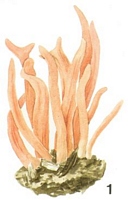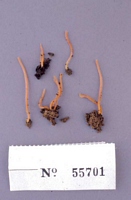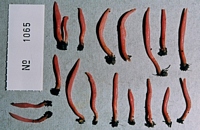|
 Clavaria corallinorosacea Clavaria corallinorosacea
SynonymsClavulinopsis corallinorosacea
BiostatusPresent in region - Indigenous. Non endemic
Images (click to enlarge)
Caption: (1) Clavaria corallino-rosacea. Taylor no. 2213. | 
Caption: Microfiche 1-5. Clavaria corallino-rosacea. TENN no. 43569. | 
Caption: 1065, id. R. Petersen, label 50x10mm, NZ, NI, Waitakere R., Mill Bay, on soil among litter under
Leptospermum-Phyllocladus-Dacrydium, 06.07.1981, leg. EH
Owner: E. Horak |
Article: Petersen, R.H. (1988). The clavarioid fungi of New Zealand. New Zealand Department of Scientific and Industrial Research, Bulletin 236: 170 pp. Wellington:.
Description: Fruit bodies up to 5 cm high, up to 3 mm thick, simple clubs, gregarious to cespitose in small
groups of up to three individuals, fusiform to subcylindrical. Club opaque, tapering slightly
upward, bright rosy pink ("peach-red", "scarlet", "grenadine-red", "salmon-orange"). Stipe
poorly delimited from hymenium, not expanded below; stipe apex concolourous with club
("scarlet", "grenadine-red"), becoming orange then peach downward ("orange-chrome",
"capucine-yellow", "salmon-orange", "light salmon-orange", "pale orange-yellow", "light
orange-yellow").
Taste and odour negligible.
Tramal hyphae of club 2-6 µm diam., hyaline, clamped (but with common unclamped septa),
thin-walled, adherent, uninflated, parallel, involving some acicular crystalline material.
Hymenium thickening, maturing slowly and well below club apex; basidia 35-50 x 6-7 µm,
clavate, clamped, yellow-refringent under phase contrast; sterigmata 4, slender, curved-divergent.
Spores 5.6-7.7 x 3.5-4.9 µm, ellipsoid to amygdaliform, often narrowed apically, smooth,
thin-walled; contents opalescent, refringent under phase contrast; hilar appendix small,
subpapillate, inconspicuous.
Notes: This species has been discussed more fully elsewhere (Petersen 1969). It is striking in the
field and should be confused with no other. Clavaria phoenicea var. persicina approximates
its colours, but produces globose spores.
Dried fruit bodies change colour to fleshy ochre, just as those of many other taxa, but often a
hint of darker, brighter colour remains on the upper stipe and/or lower club, perhaps as a
result of bruising during picking. Otherwise, micromorphology must be relied on for sure
separation of species when the fruit bodies are dry.
|